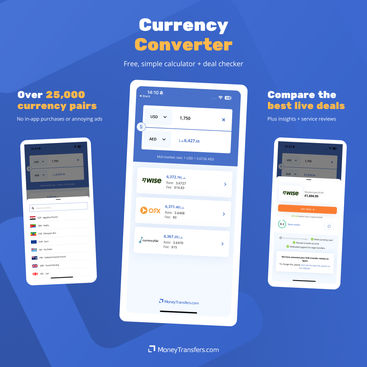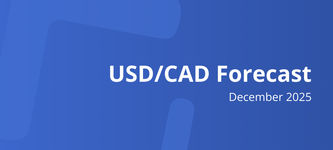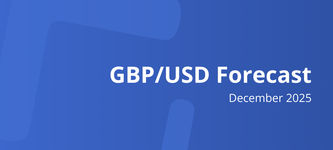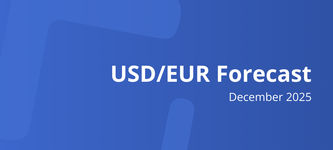GBP to CAD Forecast - December 2025
If you're planning to send money from the UK to Canada, or the other way around, this month, it's important to understand the current GBP to CAD exchange rate trends.
The rate has been somewhat volatile, hovering around 1.848989. In the short term, it could dip slightly, but there's also a chance it will rebound in the coming weeks.
Here’s what this means for your money and what we expect over the next month.
Search Now & Save On Your Transfer
What is likely to happen to GBP/CAD in December 2025
GBP to CAD is leaning downward because the UK looks closer to cutting interest rates while Canada remains steady. The key zone to watch is 1.8326. If it holds, the pair may bounce. If it breaks, GBP could weaken further.
GBP to CAD: Where It Stands
GBP to CAD has been trending weaker in recent weeks, with the pair moving toward the lower end of its typical trading range.
The Pound has struggled because markets expect the Bank of England to cut interest rates soon, while recent strong Canadian job numbers and steady Bank of Canada policy have helped support the Canadian Dollar.
Oil price swings have added volatility, but overall bias has been slightly in favour of CAD.
What’s Driving GBP to CAD?
A simple breakdown of the main forces behind the exchange rate.
UK interest rates are expected to fall, which usually weakens the Pound because it makes UK investments less attractive.
Canadian interest rates are expected to stay unchanged for longer, helping the Canadian Dollar.
Strong Canadian employment data has increased confidence in CAD.
Oil prices matter a lot for Canada. Falling oil prices can weaken CAD, but when oil stabilises, CAD typically finds support.
UK economic data is soft, with rising unemployment and slower growth adding pressure on GBP.
What Do the Charts Say?
GBP to CAD has broken below important short term moving averages and is moving toward the bottom of its recent range. The well watched range is roughly 1.8650 on the top and 1.8326 on the bottom.
Momentum favours more weakness, but a clear break below 1.8326 is not guaranteed unless fresh negative news for the Pound appears. Resistance sits near 1.8500 to 1.8560.
What to Watch in December 2025
The major upcoming events that could move the rate.
UK inflation and jobs data. Softer numbers would increase odds of a Bank of England rate cut and push GBP lower.
Canadian inflation numbers. Stronger than expected readings would support CAD by reducing the chance of future rate cuts.
Oil prices. If oil recovers, CAD typically strengthens.
General global risk mood. CAD tends to perform better when markets feel confident about global growth.
Risks Ahead
Important factors that could surprise the market.
A sharp drop in oil prices could weaken CAD unexpectedly.
A rise in UK inflation could delay Bank of England cuts and give GBP a lift.
Political uncertainty in the UK could add pressure to the Pound.
Sudden shifts in the US Dollar could indirectly affect both GBP and CAD.
What This Means If You Are Sending GBP to CAD Abroad
The overall picture suggests GBP to CAD may drift slightly lower over the next month. This means your Pounds may buy fewer Canadian Dollars if the trend continues. If you need to send money soon, you may want to monitor the rate regularly and consider moving when GBP sees small rebounds toward the 1.85 area. If you can wait, be aware that risks are mostly tilted toward a weaker Pound unless UK data improves.
Live GBP to CAD exchange rates
Converting GBP to CAD
If you are planning to send GBP to Canada, you need to pick the right money transfer company to get the most CAD on the other end.
Depending on your needs, it's best to use one of the following companies in December:
Money transfer company | GBP/CAD exchange rate | GBP/CAD fee | GBP/CAD transfer time | CAD received |
|---|---|---|---|---|
Wise (Best GBP/CAD rate) | 1.8457 GBP/CAD | 20.01 | within a week | 11,036.97 |
Key Currency (Lowest Fee) | 1.8423 GBP/CAD | 0 | minutes - 3 days | 11,053.5 |
Key Currency (Overall cheapest) | 1.8423 GBP/CAD | 0 | minutes - 3 days | 11,053.5 |
Currencyflow (Fastest Option) | 1.8421 GBP/CAD | 0 | minutes - 24 hours | 11,052.4 |
*Based on our data of £6,000 transfer from the UK to Canada in December 2025. For other amounts, please .
History of the GBP to CAD pair
The GBP/CAD pair has had a long history due to the close trading relationship between the UK and Canada.
They both are western allies and members of the G7, G20, OECD, and other organizations.
The British pound was first introduced in 1,489 and was the most used currency for centuries.
It was also used in most British colonial countries, including Canada which shifted from sterling to the Canadian dollar in 1,858.
The Canadian dollar has done better than the British pound over the years as the role of the UK in global affairs has diminished.
Indeed, the GBP to CAD pair has dropped from a high of 2.8 in December 1980 to the current 1.61, which is a ~44% decline.
The British pound has struggled because of the rising challenges faced by the country.
In 2016, the country voted to leave the European Union (EU), its biggest trading partner but this resulted in struggles faced by several core sectors in the country.
For example, the automobile sector which employed millions of people has shrunk as the number of cars manufactured in 2022 dropped to the lowest point since the 1950s.
On the other hand, Canada has benefited from its close relationship with the United States and the robust energy markets.
It has emerged as a top player in other commodities like gold and silver; and is the fourth-biggest oil producer in the world after the US, Saudi Arabia, and Russia.
The chart below shows the performance of the GBP/CAD pair since 1975.
| Date | 1 Pound Sterling in CAD |
|---|---|
| Dec 19, 2025 | 1.845696 CAD |
| Dec 20, 2025 | 1.834176 CAD |
| Dec 21, 2025 | 1.844932 CAD |
| Dec 22, 2025 | 1.851940 CAD |
| Dec 23, 2025 | 1.849389 CAD |
| Dec 24, 2025 | 1.845683 CAD |
| Dec 25, 2025 | 1.847182 CAD |
| Dec 26, 2025 | 1.847093 CAD |
| Dec 27, 2025 | 1.848989 CAD |
| Dec 28, 2025 | 1.848989 CAD |

Our handy, modern currency app lets you:
Instantly convert 25,000+ currency pairs
Compare live transfer deals
Get reviews & insights
Our app is free for mobiles and tablets, with no intrusive ads or in-app purchases.
Related Content




Contributors





